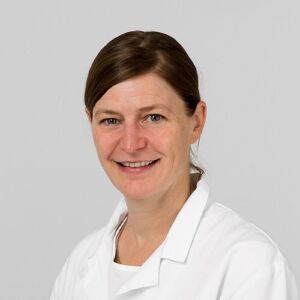Laproscopic fundoplication according to Nissen
Fundoplication, first described by the German surgeon Rudolf Nissen (1896-1981) in 1956 during his time as Director of the Department of Surgery at the University of Basel, was the world’s first permanently effective anti-reflux operation. The surgical technique described by Rudolf Nissen involves the formation of a new „valve“ between the esophagus and the stomach in order to permanently prevent the stomach contents from flowing upwards. The valve consists of the upper part of the stomach, which is placed around the lower esophagus like a collar and sutured to itself.
Today, this procedure is almost always minimally invasive, i.e. performed without a large abdominal incision.
Minimally invasive fundoplication according to Nissen is considered the standard procedure today and is certainly the most frequently performed and proven anti-reflux operation worldwide. Studies have shown that around 85-90% of patients who have undergone surgery are still satisfied with the results long after the operation (5-10 years).
Laparoscopic fundoplication according to Toupet
Toupet fundoplication is a variant of Nissen fundoplication in which only a partial sleeve is placed around the posterior part of the esophagus. This procedure is preferably used for patients with impaired swallowing function.
Laparoscopic fundoplication according to Dor
Dor’s fundoplication is also a modification of Nissen’s circular cuff. In this operation, the gastric sleeve is placed exclusively around the front part of the esophagus. This procedure is also used in particular for patients with impaired swallowing function.
Laparoscopic gastroplasty according to Collis with fundoplication according to Nissen
In a very small proportion of patients with particularly severe reflux symptoms, a scarred shortening of the esophagus can occur over the years. These patients then require surgical lengthening of the esophagus so that the fundoplication sleeve can be applied without tension. This lengthening is carried out with the help of a special stapler.
Laparoscopic sphincter augmentation with magnetic implant (LINX®)
This procedure has only been available for the treatment of reflux disease for a few years. Instead of a gastric sleeve, the valve is formed from an implant. The implant consists of a chain of titanium-encapsulated permanent magnets and is placed around the lower esophagus using a minimally invasive technique.
This strengthens the natural valve between the esophagus and stomach and prevents reflux. However, the LINX® implant is only approved for patients with mild reflux symptoms. Compared to classic fundoplication, this procedure has the advantage that the natural anatomy of the esophagus and stomach is largely preserved during the operation.
Laparoscopic implantation of an electrostimulator (EndoStim®)
Like implantation of the magnetic system (LINX®), electrical stimulation of the sphincter muscle between the esophagus and stomach using the EndoStim® procedure has only been approved for the treatment of reflux disease for a few years. During the operation, two electrodes are anchored to the lower esophagus and connected to a pacemaker placed under the skin.
The pacemaker now stimulates the lower sphincter and in this way prevents the backflow of acid into the esophagus. This operation is only offered at a few centers in Switzerland and is only approved for patients with mild symptoms. The main advantage of this technique is also the minimal stress caused to the patient during the procedure.


